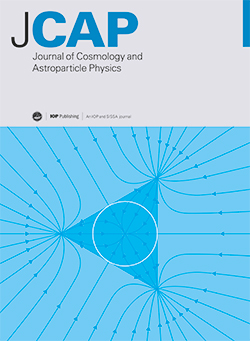Effect of dark matter interaction on hybrid star in the light of the recent astrophysical observations
IF 5.3
2区 物理与天体物理
Q1 ASTRONOMY & ASTROPHYSICS
Journal of Cosmology and Astroparticle Physics
Pub Date : 2024-10-17
DOI:10.1088/1475-7516/2024/10/064
引用次数: 0
Abstract
We have explored the effect of dark matter interaction on hybrid star (HS) in the light of recent astrophysical observational constraints. The presence of dark matter is assumed to be there in both the hadron as well as the quark sector. The dark matter particle interacts with both hadron and quark matter through the exchange of a scalar as well as a vector meson. The equation of state (EOS) of the hadron part is computed using the NL3 version of the relativistic mean field(RMF) model, whereas the quark part is taken care of using the well-known MIT Bag model with the vector interaction. We investigate the effect of the dark matter density and the mass of the dark matter particle on various observables like mass, radius, tidal deformability of the dark matter admixed hybrid star(DMAHS). In this study, we have noted an intriguing aspect that is the speed of sound in the DMAHS is insensitive to both the mass as well as the density of dark matter. We also observe a striking similarity in the variation of transition mass and its corresponding radius, as well as the maximum mass of neutron stars, with dark matter density and mass. We employ observational constraints from neutron stars to narrow down the allowed range of the parameters of dark matter.从最近的天体物理观测看暗物质相互作用对混合星的影响
我们根据最近的天体物理观测约束条件,探讨了暗物质相互作用对混合星(HS)的影响。我们假定在强子和夸克扇区都存在暗物质。暗物质粒子通过交换标量和矢量介子与强子和夸克物质相互作用。强子部分的状态方程(EOS)是用相对论平均场(RMF)模型的 NL3 版本计算的,而夸克部分则是用著名的 MIT Bag 向量相互作用模型计算的。我们研究了暗物质密度和暗物质粒子质量对暗物质混合混合星(DMAHS)的质量、半径、潮汐变形性等各种观测指标的影响。在这项研究中,我们注意到一个耐人寻味的方面,即 DMAHS 的声速对暗物质的质量和密度都不敏感。我们还观察到过渡质量及其相应半径的变化,以及中子星的最大质量与暗物质密度和质量的变化有着惊人的相似性。我们利用中子星的观测约束来缩小暗物质参数的允许范围。
本文章由计算机程序翻译,如有差异,请以英文原文为准。
求助全文
约1分钟内获得全文
求助全文
来源期刊

Journal of Cosmology and Astroparticle Physics
地学天文-天文与天体物理
CiteScore
10.20
自引率
23.40%
发文量
632
审稿时长
1 months
期刊介绍:
Journal of Cosmology and Astroparticle Physics (JCAP) encompasses theoretical, observational and experimental areas as well as computation and simulation. The journal covers the latest developments in the theory of all fundamental interactions and their cosmological implications (e.g. M-theory and cosmology, brane cosmology). JCAP''s coverage also includes topics such as formation, dynamics and clustering of galaxies, pre-galactic star formation, x-ray astronomy, radio astronomy, gravitational lensing, active galactic nuclei, intergalactic and interstellar matter.
 求助内容:
求助内容: 应助结果提醒方式:
应助结果提醒方式:


